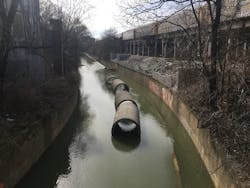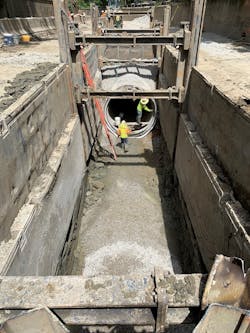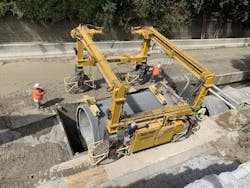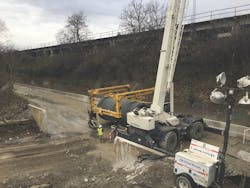Derby City Combined Sewer Overflow Solution
Shallow pipe cover, pipe storage challenges and nearby railroad tracks limited pipe options for the Lexington and Payne Combined Sewer Overflow (CSO) Interceptor, a CSO project in Louisville, Kentucky. More than 800 U.S. cities have combined sewer systems (CSS) that carry sewer and storm water. A downpour or snowmelt can overwhelm CSS pipes and drive untreated water into rivers and streams. Messy and foul smelling, CSO is a common water pollution problem that requires mitigation.
About Combined Sewer Overflows (CSO)
According to the U.S. EPA, approximately 40 million people live in communities with a CSS. A remnant of America’s early infrastructure, CSSs were designed to transport wastewater to treatment plants and direct excess wastewater — more commonly known as CSO — into nearby rivers or lakes during periods of heavy rain or snowmelt.
About the Project
Louisville and Jefferson County Metropolitan Sewer District (MSD) operates more than 3,200 miles of sanitary sewer lines and collects wastewater from approximately 270,000 homes and businesses. To correct the CSO problem, engineers designed a new pipeline to collect and divert CSO water to its Waterway Protection Tunnel, a new storage tunnel 200 feet below ground. When a rain event ends and treatment capacity is available, water is pumped from the tunnel and sent to the collection system for conveyance to the Morris Forman Water Quality Treatment Center. According to Jacob Mathis, P.E., a senior engineer with MSD, this project was unlike most.
“This project proposed a unique set of challenges, such as the diversion of an existing blue-line stream around the work area, increased flow in the creek from rain events as small as 1/10-inch, flooding of the work area from backwater of the Ohio River during periods of heavy rain, and keeping a pipe with limited cover in place with 20-feet of water above it,” Mathis said.
When specifying pipe, engineers considered three primary factors. First, the new pipeline is located directly under a concrete creek bed with shallow pipe cover available. Second, prior to installation and due to limited staging area adjacent to the creek, the pipe is stored in the creek which is subject to frequent flooding. And lastly, the nearby railroad tracks limited material options.
The Concrete Solution
Garney Construction was the primary contractor. According to Garney project manager Jeff Seal, the location required special considerations because “surface conditions included hard rock and poor alluvial soils.” To prevent floating, flexible pipe requires at least 4 to 6 feet of cover and the pipe cannot be stored in areas where flooding occurs, but this project was in an improved concrete channel.
“During construction, flow was diverted to one side of the channel using a gravity system constructed from a slip-formed barrier wall,” Seal said.
The design concept of prestressed concrete cylinder pipe (PCCP, AWWA C301) features a steel cylinder for water-tightness and a rugged, high-strength concrete structural core circumferentially prestressed with high strength steel wire. The portland cement-rich mortar coating provides a passivating alkaline environment for the steel cylinder, joint rings and prestressing wire to protect against corrosion. Since concrete continues to gain strength while underground, the PCCP will continue to provide service for years to come.
C301 Features
A rigid conduit, PCCP requires no special bedding or backfill under normal ground conditions. Installing any other pipe material often requires bracing, highly compacted bedding, trucking in aggregate, etc. and each adds cost, time and potential problems.
Additionally, PCCP has the high strength to withstand internal and external loads. The concrete and steel wall is prestressed with steel wire to provide more-than-sufficient strength to withstand the pressure requirements. The rigid wall fully supports the external forces of the surrounding earth. Prestressed concrete pressure pipe is the only piping material that is designed for the simultaneous application of internal pressure and external load.
PCCP also has built-in corrosion protection. The high pH, alkaline environment provided by the portland cement concrete and mortar provides electrochemical protection against corrosion for the encased steel components. This can be better than barrier-type protection offered by polyethylene encasements, tape wraps and paint.
The pipe can also be custom-designed for each application, meaning the customer does not pay for unnecessary strength. Each section of pipe, along with the fittings, are designed and fabricated to meet project-specific internal pressure and external loadings.
There are two types of PCCP: lined cylinder pipe (LCP) and embedded cylinder pipe (ECP). First used in North America in 1942, LCP consists of a welded steel cylinder with steel joint rings at each end, an internal concrete lining, high-tensile strength steel wire wrapped directly on the steel cylinder and an external coating of portland cement mortar. LCP is generally used for smaller pipe diameters between 16 and 48 inches.
ECP consists of a welded steel cylinder with steel joint rings at each end that is embedded in a concrete core. It has high-tensile strength steel wire wrapped on the exterior concrete core surface and an external coating of portland cement mortar. First installed in North America in 1953, ECP is typically used for 54- to 144-inch diameter pipe. ECP was selected as this project required pipe diameters of 84, 96 and 102 inches.
Joint Protection
To ensure longevity, Thompson Pipe Group manufactures joints with three layers of protection. Unlike the pipe itself, in which steel components are encased in protective concrete or mortar during manufacturing, sealing portions of the steel joint rings are not encased.
To protect these steel components, Thompson Pipe Group incorporates three layers of exterior protection:
- Zinc metallized coating;
- Cement mortar/grout; and
- Typar/Ethafoam.
The use of zinc metallized rings provides corrosion protection for the steel joint rings and eliminates the need to mortar point the interior joints on water and treated wastewater lines. Zinc metalizing provides corrosion protection for the steel as a barrier and through galvanic action.
During installation, the exterior portions of the joints are covered in portland cement grout. The primary function is to protect exposed steel components of the joint. Portland cement grout provides electrochemical protection, as well. When steel is encased in a highly alkaline environment like grout, with high pH between 12.5 and 13.5, the surface of the steel is passivated and will not oxidize.
Concrete pressure pipe comes with two-ply diapers that consist of a Typar synthetic fabric layer with a 0.25-inch closed-cell foam Typar lining, which provides an additional layer of protection. This combination of Typar and Ethafoam creates a barrier between the joint rings and corrosive material in the soil or groundwater.
Joint Testing
Thompson Pipe Group manufactured nearly 4,500 linear feet of 84- to 102-inch diameter pipe with testable joints. Testable joints are leak free and do not allow infiltration. A post construction hydrostatic test was not feasible in this situation, but with testable joints contractors can air test joints in the field at the time of installation and confirm leak-free joints.
Harness clamp joints provided restraint where necessary. The two-part harness clamp is positioned around the joint and secured simply by tightening drawbolts on each side of the pipe.
The new pipeline was completed in fall 2020 and the tunnel will go in operation in fall 2021.
About the author: Kevin Baas, P.E., is senior technical resource manager for Thompson Pipe Group. Baas can be reached at [email protected].



